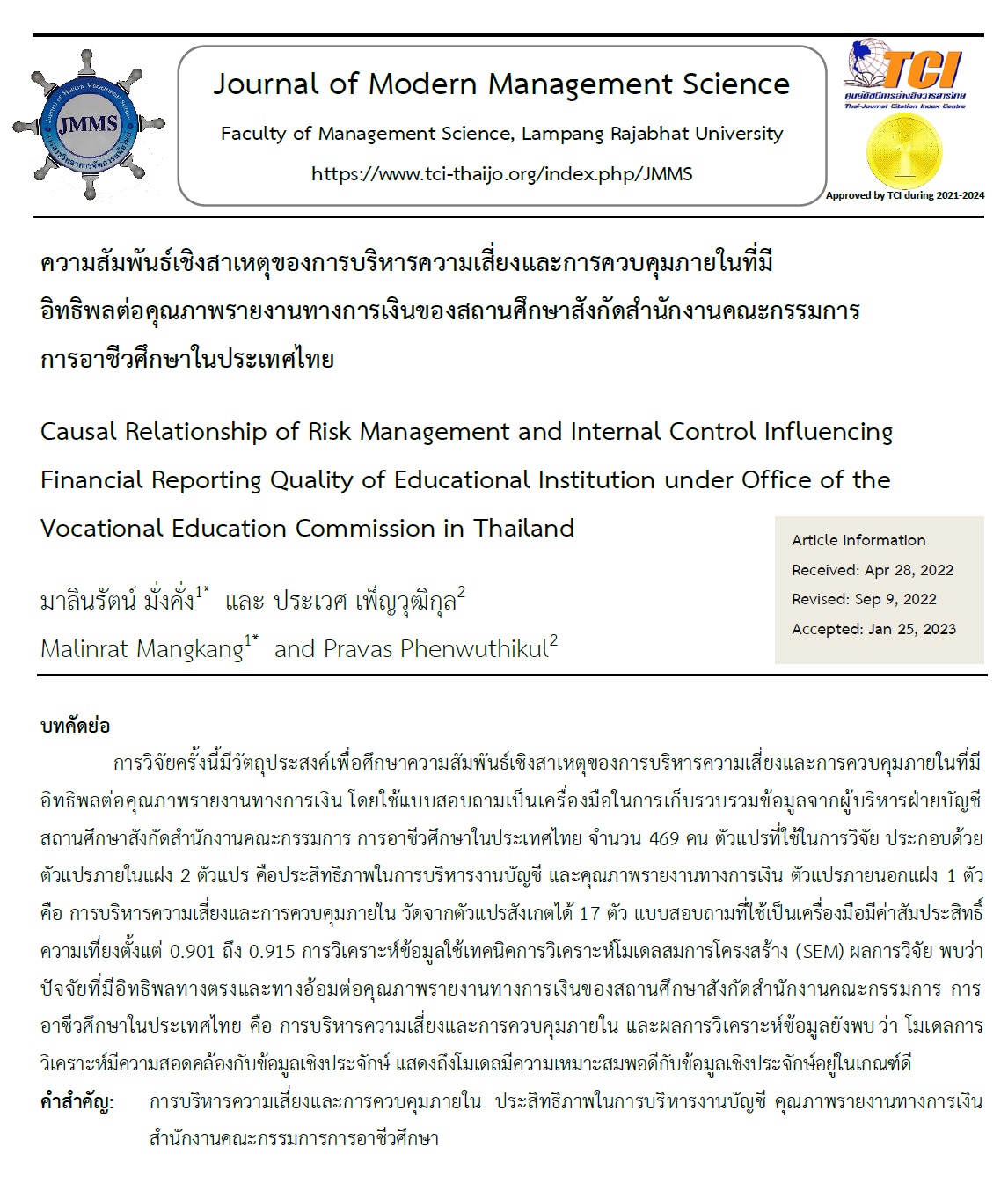Causal Relationship of Risk Management and Internal Control Influencing Financial Reporting Quality of Educational Institution under Office of the Vocational Education Commission in Thailand
Main Article Content
Abstract
The purpose of this research was to study the causal relationship of risk management and internal control influencing financial reporting quality, by using a questionnaire as an instrument for collecting data from 469 accounting executive officers of Educational Institution under Office of the Vocational Education Commission in Thailand; the variables consisted of two endogenous latent variables: accounting management efficiency, financial reporting quality; and one exogenous latent variable risk management and internal control. These latent variables were measured by 17 observed variables. The questionnaire was used as a research instrument with composite reliability between 0.901-0.915. Data was analyzed by SEM. The results showed that variable having direct and indirect effects on financial reporting quality of Educational Institution under the Office of the Vocational Education Commission in Thailand. The results of this study show that the measurement model was in congruence with the empirical data. This model exhibits the goodness of fit.
Article Details

This work is licensed under a Creative Commons Attribution-NonCommercial-NoDerivatives 4.0 International License.
The article must be considered and accepted for publication by the editorial board of the Faculty of Management Science, Lampang Rajabhat University. The articles have been reviewed by a peer (peer review) and the author must update according to the suggestion if available before publication. Articles that are not considered the editorial team will inform the results of the consideration but will not send the original to the author.
JMMS is the Faculty of Management Science journal, Lampang Rajabhat University. Jmms published both print and online editions. We allow the use of articles for academic use under the scope of copyright law.
References
______________. (2564). จำนวนสถานศึกษาในสังกัดสำนักงานคณะกรรมการการอาชีวศึกษา ปีการศึกษา 2564. สารสนเทศและกำลังคนอาชีวศึกษา,. สืบค้นเมื่อ 28 ตุลาคม 2564, จาก http://techno.vec.go.th/Default.aspx?tabid=659
ณัฐชากร เวชศรี และสุภา ทองคง (2565). การบริหารความเสี่ยงตามกรอบแนวคิด COSO ERM 2017 ที่มีผลต่อประสิทธิภาพการทำงานของผู้ทำบัญชีของสำนักงานบัญชีในเขตกรุงเทพมหานคร. วารสารนวัตกรรมการบริหารและการจัดการ, 10(2), 43-52.
สำนักงานคณะกรรมการการอาชีวศึกษา. (2564). รายงานสรุปผลการปฏิบัติงานตรวจสอบภายในประจำปีงบประมาณ พ.ศ. 2564. หน่วยตรวจสอบภายใน. สำนักงานคณะกรรมการการอาชีวศึกษา.
Aaker, D. A., Kumar, V. & Day, G. S. (2001). Marketing Research. New York: John Wiley and Son.
Ajao, O.S. & Oluwadamilola, A.O. (2020). Internal Control Systems and Quality of Financial Reporting in Insurance Industry in Nigeria. Journal of Finance and Accounting, 8(5), 218-226.
Barclay, D., Higgins, C. & Thompson, R. (1995). The partial least squares (PLS) approach to causal modeling: Personal computer adoption and use as an illustration. Technology studies, 2(2), 285-309.
Bordeleau, F.E., Mosconi, E. & De Santa-Eulalia, L.A. (2020). Business Intelligence and Analytics Value Creation in Industry 4.0: A Multiple Case Study in Manufacturing Medium Enterprises. Production Planning and Control, 31(1), 1-13.
Chow, W.S. & Chan, L.S. (2008). Social network, social trust and shared goals in organizational knowledge sharing. Information and Management, 45(7), 458-462.
Farida, I., Mulyani, S., Akbar, B., & Setyaningsih, S.D. (2021). Quality and Efficiency of Accounting Information Systems. Utopia y Praxis Latinoamericana, 26(2), 323-337.
Fornell, C. & Larcker, D.F. (1981). Evaluating structural equation models with unobservable variables and measurement error. Journal of Market Research, 18(1), 39-50.
Hair, J.F., Black, W.C., Babin, B.J. & Anderson, R.E. (2010). Multivariate data analysis: A global perspective. (7th ed.). New Jersey: Pearson Education Inc.
International Accounting Standards Board (2018). Conceptual Framework for Financial Reporting.
Jensen, M., & Meckling, W. (1976). Theory of the Firms: Managerial Behavior, Agency Costs and Ownership Structure. Journal of Financial Economics, 3(1), 305-360.
Kaawaase, T.K., Nairuba, C., Akankunda, B. & Bananuka, J. (2021). Corporate Governance, Internal Audit Quality and Financial Reporting Quality of Financial Institutions. Asian Journal of Accounting Research, 6(3), 348-366.
Kose, T. & Agdeniz, S. (2019). The Role of Management Accounting in Risk Management. The Journal of Accounting and Finance, 5(1), 509-526.
Madu, M. & Hassan, S.U. (2021). Enterprise Risk Management and Financial Reporting Quality: Evidence from Listed Nigerian Non-financial Firms. Journal of Risk and Financial Studies, 2(1), 43-70.
Nalukenge, I., Tauringana, V. & Ntayi, J.M. (2017). Corporate Governance and Internal Controls over Financial Reporting in Ugandan MFIs. Journal of Accounting in Emerging Economies, 7(3), 294-317.
Nunnally, J.C. & Bernstein, I.H. (1994). Psychometric Theory. (3rd ed.). New York, NY:McGraw-Hill.
Nunnally, J.C. (1978). Psychometric theory. New York: McGraw-Hill.
Overton, T. S. (1977). Estimating Nonresponse Bias in Mail Surveys. Journal of Marketing Research, 14(1), 396-402.
Schumacker, R.E. & Lomax, R.G. (2010). A beginner’s guide to structural equation modeling. (3rd ed). New Jersey: Lawrence Erlbaum Associates.
Thabit, T.H., Solaimanzadah, A. & Mohammed, M.A. (2019). Determining the Effectiveness of Internal Controls in Enterprise Risk Management based on COSO Recommendations. International Conference on Accounting, Business, Economics and Politics, 1(2019), 381-390.


